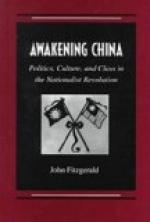Let us take an imaginary journey through the provinces and begin at Hong Kong, where, in 1850, I began my actual experience of life in China.
From the deck of the good ship Lantao, which had brought me from Boston around the Cape in one hundred and thirty-four days, I gazed with admiration on the Gibraltar of the Orient. Before me was a land-locked harbour in which all the navies of the world might ride in safety. Around me rose a noble chain of hills, their slopes adorned with fine residences, their valleys a chessboard of busy streets, with here and there a British battery perched on a commanding rock.
Under Chinese rule Hong Kong had been an insignificant fishing village, in fact a nest of pirates. In 1841 the island was ceded by China to Great Britain, and the cession was confirmed by the treaty of Nanking in August, 1842. The transformation effected in less than a decade had been magical; yet that was only the bloom [Page 8] of babyhood, compared with the rich maturity of the, present day.
A daily steamer then sufficed for its trade with Canton; a weekly packet connected it with Shanghai; and the bulk of its merchandise was still carried in sailing ships or Chinese junks. How astounding the progress that has marked the last half-century! The streets that meandered, as it were, among the valleys, or fringed the water’s edge, now girdle the hills like rows of seats in a huge amphitheatre; a railway lifts the passenger to the mountain top; and other railways whirl him from hill to hill along the dizzy height. I Trade, too, has multiplied twenty fold. In a commercial report for the year ending June, 1905, it is stated that in amount of tonnage Hong Kong has become the banner port of the world.
Though politically Hong Kong is not China, more than 212,000 of its busy population (about 221,000) are Chinese; and it is preeminently the gate of China. By a wise and liberal policy the British Government has made it the chief emporium of the Eastern seas.
We now take a trip to Canton and cross a bay studded with islands. These are clothed with copious verdure, but, like all others on the China coast, lack the crowning beauty of trees. In passing we get a glimpse of Macao, a pretty town under the flag of the Portuguese, the pioneers of Eastern trade. The oldest foreign settlement in China, it dates from 1544—not quite a half-century after the discovery of the route to India, an achievement whose fourth centenary was celebrated in 1898. If it could be ascertained on what [Page 9] day some adventurous argonaut pushed the quest of the Golden Fleece to Farther India, as China was then designated, that exploit might with equal appropriateness be commemorated also.
The city of Macao stands a monument of Lusitanian enterprise. Beautifully situated on a projecting spur of an island, it is a favourite summer resort of foreign residents in the metropolis. It has a population of about 70,000, mostly Chinese, and contains two tombs that make it sacred in my eyes; namely, that of Camoeens, author of “The Lusiad” and poet of Gama’s voyage, and that of Robert Morrison, the pioneer of Protestant missions, the centennial of whose arrival had in 1907 a brilliant celebration.




